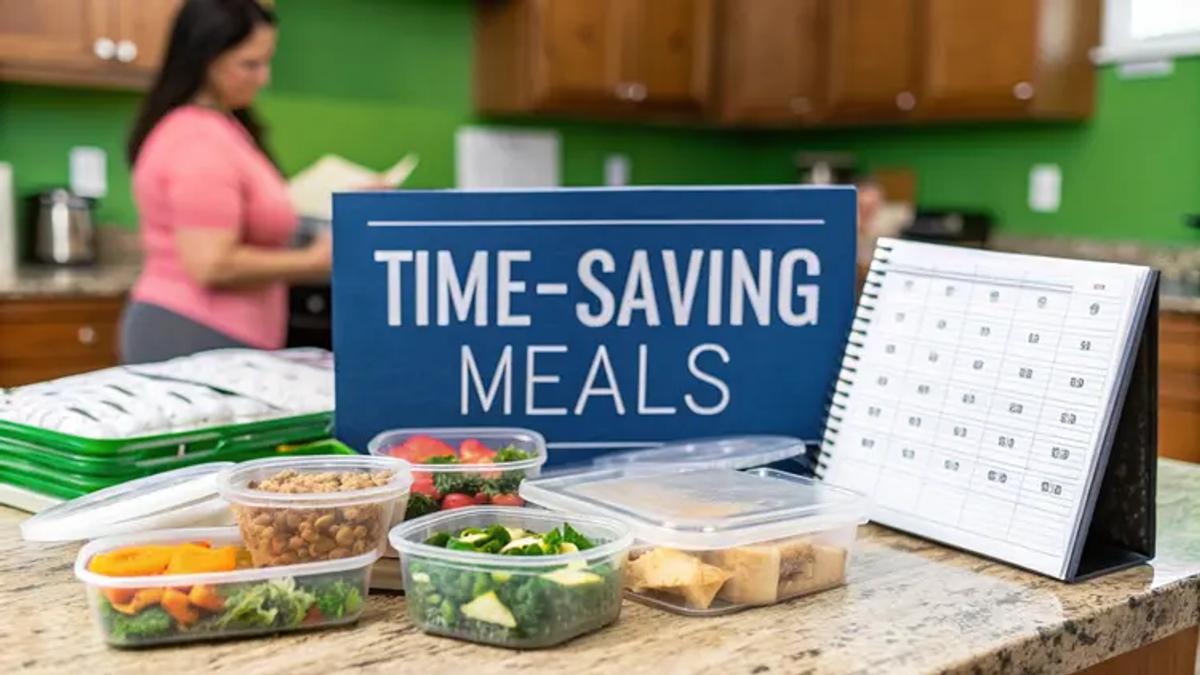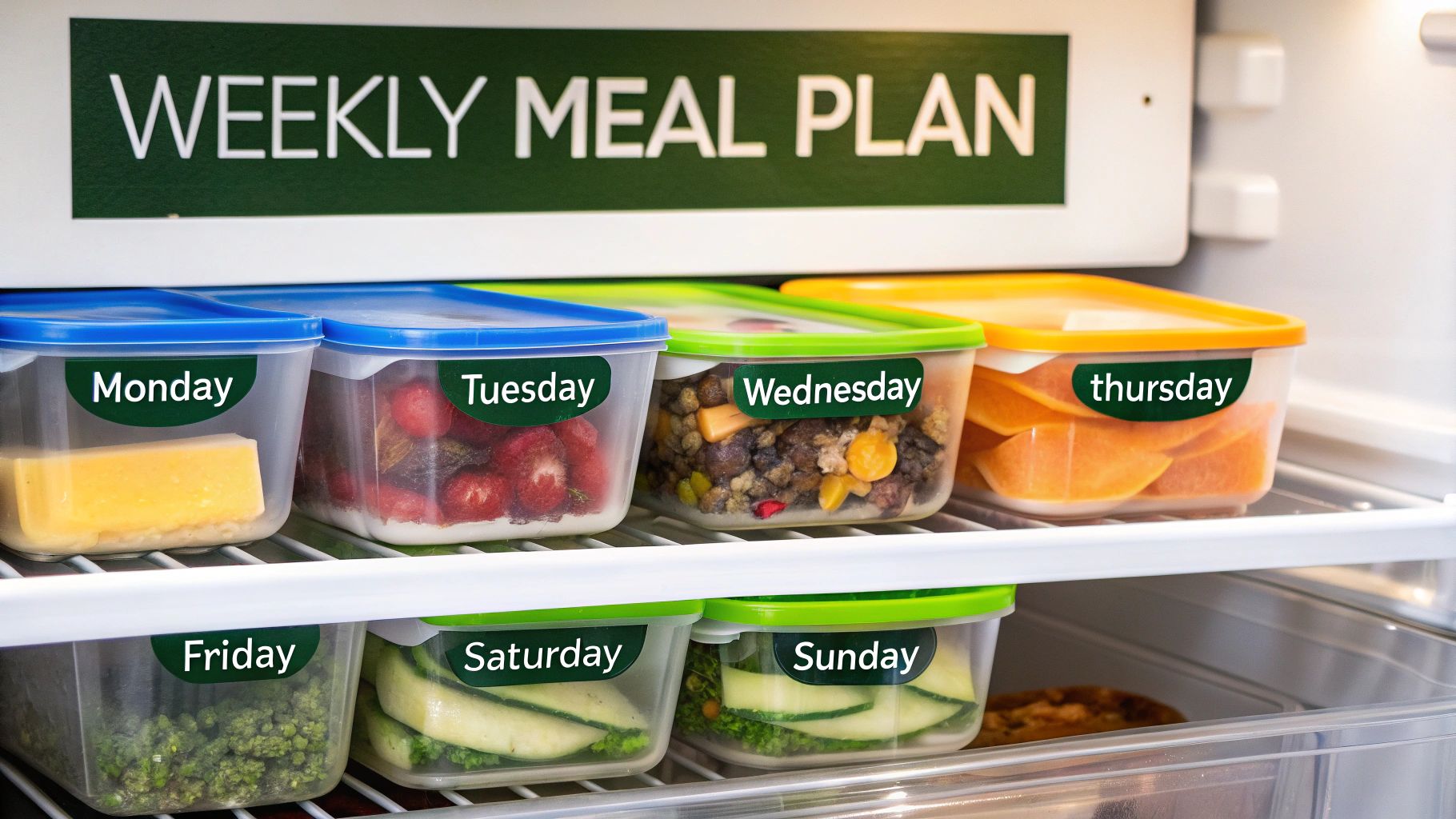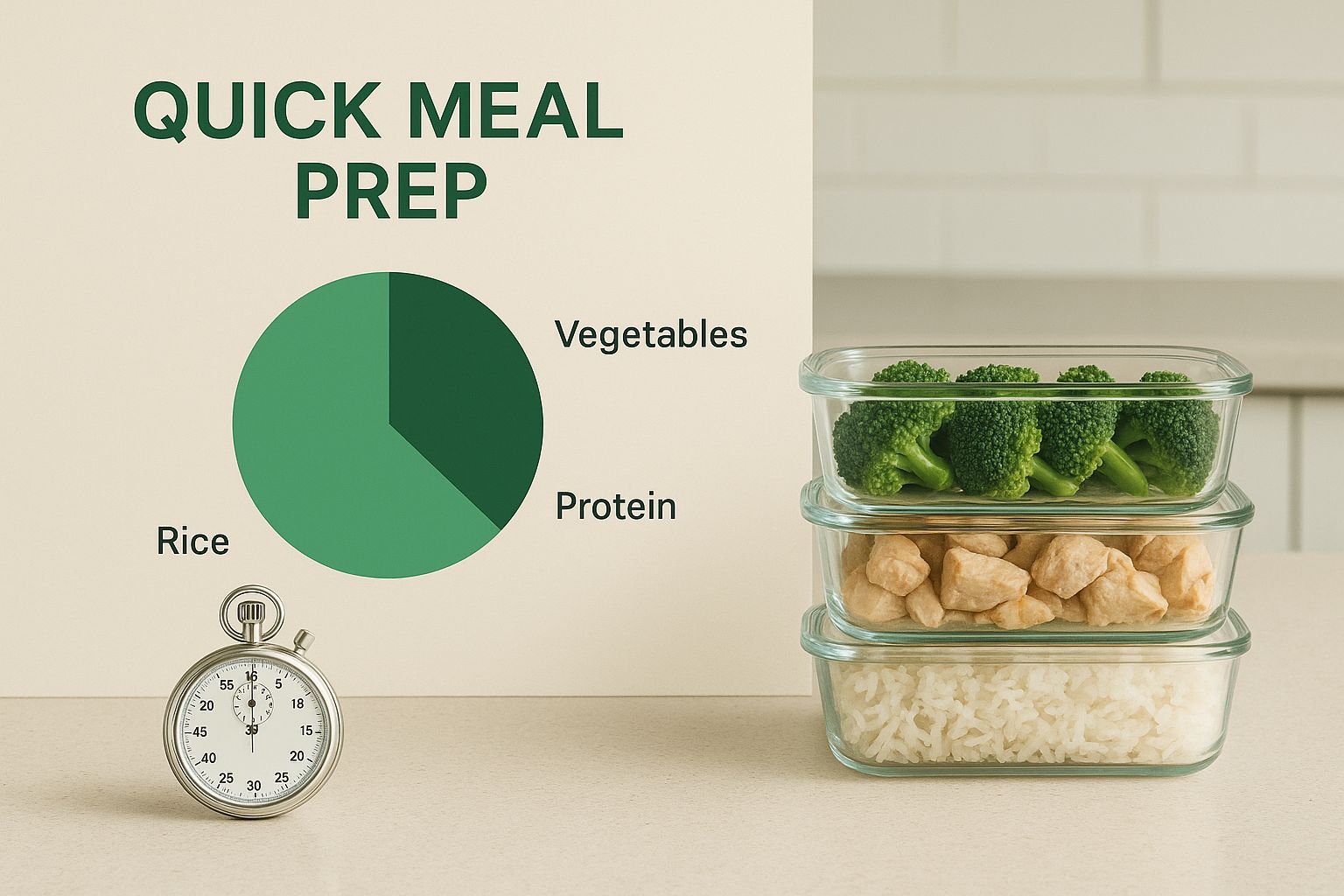Meal Planning for Busy Moms: Easy Tips to Save Time
Discover simple meal planning for busy moms. Save time and reduce stress with our expert strategies. Perfect for jugglers and supermoms alike!
Ready to Simplify Your Meal Planning?
Get personalized meal plans and grocery lists automatically matched to your macro targets.

Meal Planning for Busy Moms: Easy Tips to Save Time
Why Meal Planning Actually Saves Your Sanity

Let's be honest, the daily "what's for dinner?" question can be exhausting for busy moms. That 5 pm stare-down with the fridge is a struggle we all know too well. But there's a way to reclaim your mental energy and reduce that daily stress: meal planning.
Meal planning isn't about adding another chore to your list. Think of it as a secret weapon for unlocking more time and sanity. It's a small investment of time upfront that pays off big during the week. Imagine strolling through the grocery store with a laser-focused list, dodging impulse buys, and saving both time and money. Picture having ingredients prepped and ready when it's cooking time, eliminating the frantic scramble. Sounds pretty good, right?
Taming the Mental Load
One of the biggest benefits of meal planning is reducing decision fatigue. That's the mental exhaustion you feel after making tons of little decisions throughout the day. By planning your meals, you free up mental space for more important things, like spending time with your family or focusing on work. It also eliminates the constant stress of figuring out dinner on the fly, making for a calmer, more enjoyable evening routine. This means you can actually relax and enjoy dinner with your family, not feel frazzled and overwhelmed.
Meal planning is becoming a go-to strategy for managing family life. A 2017 study found that over 57% of participants planned their meals at least sometimes, proving more and more people are realizing its benefits. The study also linked meal planning to better dietary quality and variety, a big win for families. Want to learn more? Check out this study here.
From Takeout Emergencies to Kitchen Confidence
How often have you ordered takeout because you just couldn't deal with another dinner decision? Meal planning breaks that cycle. With a plan, you're less likely to cave to the siren song of convenience foods, saving money and making healthy eating easier. It's a proactive way to ensure your family enjoys nutritious, home-cooked meals, even on a busy schedule. This also means fewer emergency trips to the grocery store, a more organized kitchen, and a greater sense of control over your family's nutrition.
Building a Sustainable System
The key is finding a system that works for your family. Consider your schedule, what everyone likes to eat, and even your kids' ages. Whether you use a digital tool or a simple notepad, the goal is to simplify, not complicate, your life. Maybe you try theme nights, prep ingredients ahead, or even batch cook to make things easier. By customizing your approach, you're setting yourself up for long-term success and the peace of mind that comes with a solid plan.
The Unspoken Truth About Who Feeds the Family

Let's be honest, in many families, moms are the unsung heroes of the dinner table. It's not just about whipping up a delicious meal; it's the whole shebang. Think brainstorming meal ideas (while simultaneously refereeing a sibling squabble), crafting grocery lists (that inevitably get forgotten on the kitchen counter), prepping ingredients (with a toddler clinging to your leg), and finally, getting food on the table (only to hear, "I don't like this!"). It's a marathon, not a sprint, and honestly, it can be exhausting.
This isn't a rant, it's a reality check. This section dives into the often-invisible workload that moms shoulder and explores some clever ways to create a more sustainable and shared approach to mealtime madness.
The Invisible Work of Mealtime
For many moms, meal planning is a constant background hum in their brains. It's the mental gymnastics of figuring out breakfast, packing lunches, deciphering what everyone will actually eat for dinner, and ensuring the pantry isn't bare. This invisible work takes serious time and energy, even when there's no actual cooking happening.
And let's not forget the added layers of complexity: dealing with food preferences, dietary restrictions, and the dreaded picky eater. Moms aren't just feeding their families; they're managing a complex logistical operation, often solo. The numbers back this up: a 2022 survey by Motherly revealed that 55% of mothers are the primary meal planners and preparers, compared to just 19% of men. Even grocery shopping falls disproportionately on moms, with 52% taking on the task. Talk about a heavy lifting!
Shifting the Balance: Sharing the Load
The good news? This doesn't have to be a one-woman show. There are practical strategies to redistribute the meal planning burden and create a more equitable and, dare we say, enjoyable system.
- Open Communication: Start by having an honest conversation with your family about the mental and physical energy that goes into meal planning. Explain the load you carry and how it impacts you. Sometimes, just voicing the unspoken can make a world of difference.
- Delegate Responsibilities: Get everyone involved! Even young children can contribute. Think setting the table, washing vegetables, or packing their own lunches (with some supervision, of course). Partners can take on grocery shopping, meal prepping, or cooking certain nights of the week. Teamwork makes the dream work, right?
- Establish Routines: Creating predictable routines can help streamline the process and make it less reliant on one person. Assign specific meal prep tasks to each family member. For instance, one person chops veggies while another tackles the protein. Suddenly, it's a family affair!
From Resentment to Shared Responsibility
By implementing these strategies and using helpful tools like Meal Flow AI, which automates meal planning and grocery list creation (including Instacart integration!), you can transform mealtime from a source of stress into a more balanced and enjoyable family experience. Meal Flow AI takes the mental load off by generating personalized meal plans and automatically creating those pesky shopping lists. This gives busy moms back some precious time and energy, fostering a more collaborative and less stressful approach to feeding the family. This shift not only benefits moms but also teaches valuable life skills to other family members and promotes a greater appreciation for the work that goes into providing nutritious meals. Bon appétit!
Creating a Meal Planning System That Actually Sticks
Forget those generic meal planning tips you’ve seen everywhere. This is about building a system that works for you, the busy mom juggling a million things. We'll explore everything from high-tech apps to the trusty pen-and-paper method, from themed dinners to weekend batch cooking sessions. The goal? Finding what truly clicks with your family's eating habits, schedules, and, let's be honest, ever-changing preferences.
Choosing Your Meal Planning Method
Let’s face it: there's no magic, one-size-fits-all solution when it comes to meal planning. Flexibility is key. Your system should be adaptable, able to bend with life's curveballs instead of shattering into a million pieces.
- Digital Tools: For the tech-savvy mom, apps like Meal Flow AI offer personalized plans, automated grocery lists, and even integration with Instacart for seamless delivery. Talk about convenience!
- Pen and Paper: Don’t underestimate the power of a simple notebook or printable calendar. This visual, tactile approach allows for easy customization and can be surprisingly effective.
- Theme Nights: Taco Tuesdays or Pizza Fridays? Theme nights bring a sense of predictability and simplify decision-making. Plus, they're a fun way to get kids involved in the planning process.
- Batch Cooking: Devote a few weekend hours to prepping ingredients or even entire meals. This strategy maximizes efficiency and minimizes weeknight cooking chaos, freeing up precious time for other things.

This handy infographic shows just how much time you can save with meal prepping. Imagine, prepped lunch boxes ready to go – talk about a win!
To help you choose the best method for your family, check out this comparison table:
To help you choose the best method for your family, we've put together a handy comparison:
Meal Planning System Showdown: What Actually Works
Compare different meal planning approaches to find what fits your life, schedule, and organization style.
| Planning Method | Time Investment | Best For | Key Benefits | Potential Challenges |
| Digital Tools | Low (after initial setup) | Tech-savvy moms, busy schedules | Automated lists, personalized plans, convenient delivery integration | Requires tech comfort, potential subscription costs |
| Pen and Paper | Moderate | Visual planners, customizable needs | Tangible, flexible, affordable | Requires manual updates, can be disorganized |
| Theme Nights | Low | Families with picky eaters, busy weeknights | Simplifies decisions, fun for kids, predictable meals | Can become repetitive, limited variety |
| Batch Cooking | High (on weekends) | Maximizing efficiency, minimizing weeknight cooking | Saves time during the week, reduces daily stress | Requires dedicated prep time, large fridge space |
This table summarizes the pros and cons of each method, allowing you to quickly identify the best fit for your lifestyle. Remember, the best method is the one you can stick with!
Assessing Your Family's Needs
Creating a meal planning system that lasts starts with understanding your family's unique needs. Consider these key factors:
- Eating Habits: Dietary restrictions? Picky eaters? Knowing your family’s eating habits is crucial for planning meals everyone will enjoy.
- Schedule Constraints: Which nights are the busiest? How much time can you realistically dedicate to cooking? Honest answers here will help you create a sustainable plan.
- Food Preferences: What are everyone’s favorite meals? Are there any foods everyone dislikes? Take these preferences into account to avoid mealtime battles.
By honestly evaluating these areas, you can build a system that truly aligns with your family’s lifestyle. Hectic weeknights? Prioritize quick meals or slow cooker recipes. Picky eaters? Involve them in the planning process to increase buy-in.
Building in Flexibility
Let's be real: life rarely goes as planned. That's why flexibility is the secret ingredient in any successful meal planning system.
- Buffer Days: Designate one or two nights a week as "flexible" – perfect for leftovers, takeout, or super-quick meals. This prevents your system from derailing when unexpected events pop up.
- Swappable Meals: Plan meals that can be easily swapped if schedules change. Tuesday’s chicken stir-fry looking too ambitious? Swap it with Thursday’s simpler pasta dish. No problem!
- Emergency Meals: Keep a list of quick and easy go-to meals for those nights when everything goes sideways. This prevents last-minute takeout runs and ensures you always have a backup plan.
By incorporating flexibility, you create a sustainable routine that can weather life’s surprises. Meal planning shouldn’t feel restrictive. It should be a tool that empowers you to feed your family well, even when life gets crazy.
The Kitchen Time Multiplier: Cook Once, Eat Twice
<iframe width="100%" style="aspect-ratio: 16 / 9;" src="https://www.youtube.com/embed/U8n7EDwZ9U" frameborder="0" allow="autoplay; encrypted-media" allowfullscreen></iframe>
Juggling work, family, and everything in between? For busy moms, maximizing kitchen time is key. Forget the daily grind of cooking from scratch every night. This section dives into the "cook once, eat twice" philosophy – your secret weapon for stress-free weeknight meals. By strategically planning and prepping food, you can slash your cooking time and still enjoy delicious, home-cooked meals. Let's unlock the power of batch cooking, freezer meals, and component prepping to transform your meal planning routine.
Batch Cooking: Your Weekend Secret Weapon
Think of Sunday as your prep day, your chance to unleash your inner culinary superhero. Devote a few hours to batch cooking – preparing large quantities of ingredients or even complete meals. This upfront investment pays off big time during the week. Roast a whole chicken on Sunday, and watch it transform into salads, tacos, or sandwiches throughout the week. No more cooking chicken multiple times – talk about a time saver!
- Double the Recipe: When making a family favorite, double the recipe. Freeze the extra portions for a ready-made meal later.
- Focus on Staples: Batch cooking staples like rice, beans, or roasted veggies creates a foundation for quick weeknight meals. These versatile ingredients can be easily incorporated into countless dishes.
Strategic Freezer Meals: Dinner on Autopilot
Freezer meals are a busy mom's best friend. Preparing meals in advance and freezing them creates a stockpile of ready-to-go dinners. Picture this: it's a hectic Wednesday night, and you pull a delicious lasagna or a comforting soup from the freezer. No last-minute scrambling, just effortless weeknight dinners.
- Label and Date: Label and date your freezer meals to avoid freezer burn and make meal selection a breeze. You'll thank yourself later!
- Portion Appropriately: Freeze meals in family-sized portions or individual servings to minimize food waste and thawing time.
Component Prepping: Mix and Match Magic
Component prepping is all about preparing individual ingredients ahead of time. Think pre-chopped veggies, cooked grains, or marinated proteins. These prepped components become the building blocks for quick and easy meal assembly. Mix and match to create endless possibilities throughout the week.
- Prep Vegetables: Wash, chop, and store vegetables in airtight containers. Having pre-cut veggies on hand encourages healthier eating and saves precious prep time.
- Cook Grains: Cook a large batch of quinoa or brown rice and store it in the fridge. Cooked grains form a versatile base for salads, bowls, or side dishes.
Maximizing Your Time and Budget
These "cook once, eat twice" strategies not only save time but also stretch your grocery budget. By planning ahead and using ingredients strategically, you reduce food waste and avoid impulse buys. Repurposing leftovers, like using leftover roast chicken in tacos or soup, maximizes your grocery dollars and minimizes cooking time. Combine these techniques with tools like Meal Flow AI, which creates personalized meal plans and generates automated grocery lists, and you'll streamline your meal planning process like never before. Reclaim your weeknights and enjoy more quality time with your family.
Real Food, Real Life: When Nutrition Meets Reality
Balancing nutritious meals with the demands of a busy schedule can feel like a Herculean task. Let's ditch the pursuit of perfection and embrace practical strategies to bring wholesome foods to the table quickly – without becoming a kitchen hermit. Forget hours of cooking; let's explore how healthy eating can fit into the whirlwind of mom life.
Smart Swaps and Pantry Powerhouses
One of the biggest hurdles is finding time to cook elaborate meals. But smart shortcuts don't have to mean sacrificing nutrition. Identifying genuinely helpful convenience foods is a game-changer. Think pre-washed salad mixes, frozen fruits and vegetables, and pre-cooked grains. These time-savers form the base of a nutritious meal without extensive prep.
A well-stocked pantry is your best friend. Keeping staples like canned beans, lentils, whole-grain pasta, and canned tomatoes on hand lets you whip up a healthy meal in minutes. For example, combining canned chickpeas, diced tomatoes, and spices creates a delicious base for a quick curry or soup.
The 30-Minute Meal Mastery
Developing go-to nutritious meals ready in under 30 minutes is key. This doesn't mean resorting to processed foods. Focus on simple, nutrient-packed recipes that come together quickly. One-pan meals, sheet pan dinners, and stir-fries are all excellent choices.
This is where your strategic pantry shines. Combined with fresh produce and lean protein, pantry staples become satisfying, healthy meals in no time. Imagine tossing pre-cooked quinoa with black beans, corn, salsa, and grilled chicken for a flavorful bowl in minutes. Dinner is served!
Cutting Corners, Keeping Nutrition
Let's be real, sometimes corners need cutting. The key is knowing which shortcuts won't compromise your family's health. Pre-cut vegetables are a prime example. While slightly more expensive, the time saved is gold for busy moms. Similarly, frozen fruits in smoothies or desserts boost nutritional value without the washing and chopping.
Meal planning reduces stress and improves family health. Studies highlight how working mothers often experience stress related to meal planning due to the time commitment. Learn more about this. Meal planning helps manage this stress and build healthy habits.
Building Your Family's Fast & Nutritious Foundation
Strategic meal planning empowers busy moms to prioritize convenience and nutrition. Use this table to build your family's fast and nutritious meal foundation:
Fast & Nutritious Meal Building Blocks: Essential ingredients that combine quickly for healthy meals your family will actually eat
| Component Type | Key Items | Prep Time | Nutritional Benefits | Family-Friendly Meals |
| Protein | Pre-cooked chicken, canned tuna, lentils, beans | Minimal | Essential for muscle growth and repair | Salads, soups, tacos, stir-fries |
| Grains | Pre-cooked quinoa, brown rice, whole-grain pasta | Minimal | Provides energy and fiber | Bowls, side dishes, salads |
| Vegetables | Frozen vegetables, pre-washed salad mix, canned tomatoes | Minimal | Vitamins, minerals, and antioxidants | Stir-fries, soups, salads, side dishes |
| Healthy Fats | Avocado, nuts, seeds, olive oil | Minimal | Supports brain health and provides essential fatty acids | Salads, dressings, snacks |
These building blocks allow for countless quick and easy meal combinations.
By incorporating these strategies, you create a sustainable, healthy eating approach that fits your busy lifestyle. This isn't about unattainable perfection; it's about consistently making healthy, simple choices that nourish your family.
You Don't Have to Do This Alone: Building Your Food Village
Ever wonder how some meal-planning maestros make it look so easy? Their secret? They've built a food village. They’ve wisely realized that feeding the family doesn't have to be a one-person show. This section explores how you can create your own supportive meal-planning community, lightening your load and transforming mealtime from a solo mission into a shared family affair.
Empowering Your Family: Age-Appropriate Kitchen Contributions
Getting the family involved isn't just about offloading chores; it’s about teaching valuable life skills and fostering a sense of shared responsibility. The key is to identify age-appropriate contributions that genuinely help, not create more work for you.
- Toddlers (2-3 years): Think simple! Washing produce, setting the table (with unbreakable items), or even stirring ingredients. These tasks introduce them to the kitchen and build excitement around food.
- Preschoolers (4-5 years): Their growing dexterity allows for slightly more complex tasks. Measuring ingredients, spreading toppings, or tearing lettuce are all great options.
- Elementary School (6-11 years): Now we're getting somewhere! Kids this age can prepare simple snacks, pack their own lunches, or help with basic cooking tasks like chopping vegetables.
- Teenagers (12+ years): Time to unleash their inner chef! Teenagers can plan and prepare entire meals, handle grocery shopping, and even (gasp!) clean up the kitchen. These are skills they’ll need for adulting, after all.
Remember, focus on progress, not perfection. Involving kids might take more time initially, but the long-term payoff is huge.
Partnering Up: Collaborative Meal Planning
Want a truly balanced food system? Meaningful partner engagement is key. Start with open communication. Discuss your current workload, how it’s impacting you, and brainstorm solutions together.
- Shared Planning: Schedule regular meal-planning sessions to collaborate on meal ideas, consider everyone's preferences, and create grocery lists together. Think of it as a family food summit!
- Designated Responsibilities: Divide tasks based on strengths and schedules. One partner might handle grocery shopping using Instacart while the other tackles meal prep.
- Rotating Roles: Keep things fresh (pun intended!) by switching up responsibilities to avoid burnout. One week, one partner plans; the next week, the other takes the reins.
This collaborative approach not only lightens your load but also sets a great example of teamwork for your kids.
Community Connections: Expanding Your Food Network
Think beyond your immediate family. Building a supportive food network provides valuable resources and takes the pressure off you to do it all.
- Meal Exchanges: Coordinate meal swaps with other families. Each family cooks a double batch of one meal and exchanges portions. Boom! Instant variety without the extra effort.
- Local Resources: Check out community gardens, farmers' markets, or CSAs (Community Supported Agriculture) to access fresh, affordable ingredients.
- Online Communities: Join online groups or forums dedicated to meal planning for busy parents. Share tips, recipes, and commiserate with others who understand the struggle. It’s like a virtual food village!
Building this food village takes time and effort, but the rewards are well worth it. You’ll gain valuable time, reduce stress, and create a more sustainable approach to feeding your family.
Streamlining Your Village with Meal Flow AI
Meal planning can feel overwhelming, but it doesn't have to be. Meal Flow AI is designed to simplify the entire process. From generating personalized meal plans based on your family's preferences to automatically creating Instacart shopping lists, Meal Flow AI takes the mental load off your plate. Reclaim your time and energy by letting AI handle the logistics. Ready to build a more sustainable and enjoyable meal planning routine? Start your free trial of Meal Flow AI today and experience the difference.